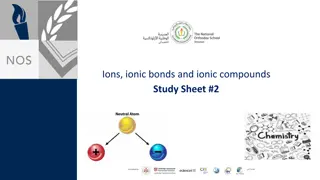Magnetic Field Problems: Protons, Wires, and Charged Ions
Solve various problems related to magnetic fields, including determining forces on protons, calculating magnetic forces on wires with currents, finding the radius of paths for charged ions in magnetic fields, and more. Understand concepts such as magnetic forces, circular orbits, and interactions between magnetic fields and moving charges.
Download Presentation

Please find below an Image/Link to download the presentation.
The content on the website is provided AS IS for your information and personal use only. It may not be sold, licensed, or shared on other websites without obtaining consent from the author.If you encounter any issues during the download, it is possible that the publisher has removed the file from their server.
You are allowed to download the files provided on this website for personal or commercial use, subject to the condition that they are used lawfully. All files are the property of their respective owners.
The content on the website is provided AS IS for your information and personal use only. It may not be sold, licensed, or shared on other websites without obtaining consent from the author.
E N D
Presentation Transcript
Chapter 29 Problems Problems 7, 9, 12, 30, 37, 41
7. A proton moving at 4.00 106 m/s through a magnetic field of 1.70 T experiences a magnetic force of magnitude 8.20 10 13 N. What is the angle between the proton s velocity and the field?
9. A proton moves with a velocity of v = (2 i 4 j + k ) m/s in a region in which the magnetic field is B = ( i + 2 j 3 k ) T. What is the magnitude of the magnetic force this charge experiences?
12. A wire carries a steady current of 2.40 A. A straight section of the wire is 0.750 m long and lies along the x axis within a uniform magnetic field, B = 1.60 T. If the current is in the +x direction, what is the magnetic force on the section of wire?
14. A conductor suspended by two flexible wires as shown in Figure P29.14 has a mass per unit length of 0.040 0 kg/m. What current must exist in the conductor in order for the tension in the supporting wires to be zero when the magnetic field is 3.60 T into the page? What is the required direction for the current?
30. A singly charged positive ion has a mass of 3.20 1026 kg. After being accelerated from rest through a potential difference of 833 V, the ion enters a magnetic field of 0.920 T along a direction perpendicular to the direction of the field. Calculate the radius of the path of the ion in the field.
37. A cosmic-ray proton in interstellar space has an energy of 10.0 MeV and executes a circular orbit having a radius equal to that of Mercury s orbit around the Sun (5.80 1010 m). What is the magnetic field in that region of space?
41. Singly charged uranium-238 ions are accelerated through a potential difference of 2.00 kV and enter a uniform magnetic field of 1.20 T directed perpendicular to their velocities. (a) Determine the radius of their circular path. (b) Repeat for uranium-235 ions. What If? How does the ratio of these path radii depend on the accelerating voltage and on the magnitude of the magnetic field?























